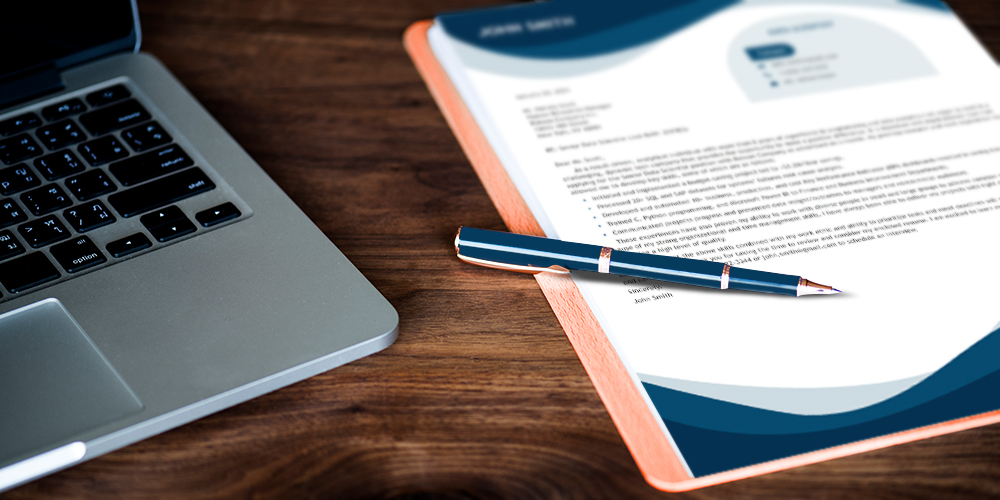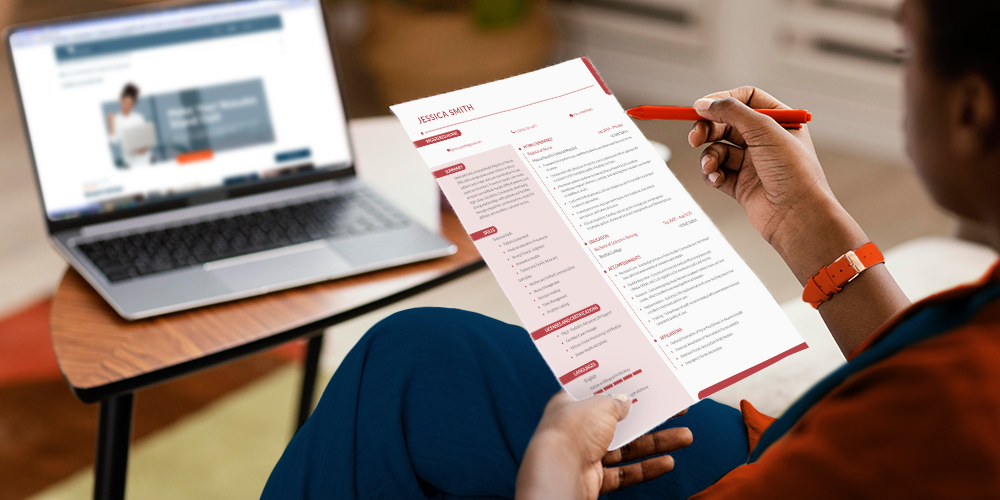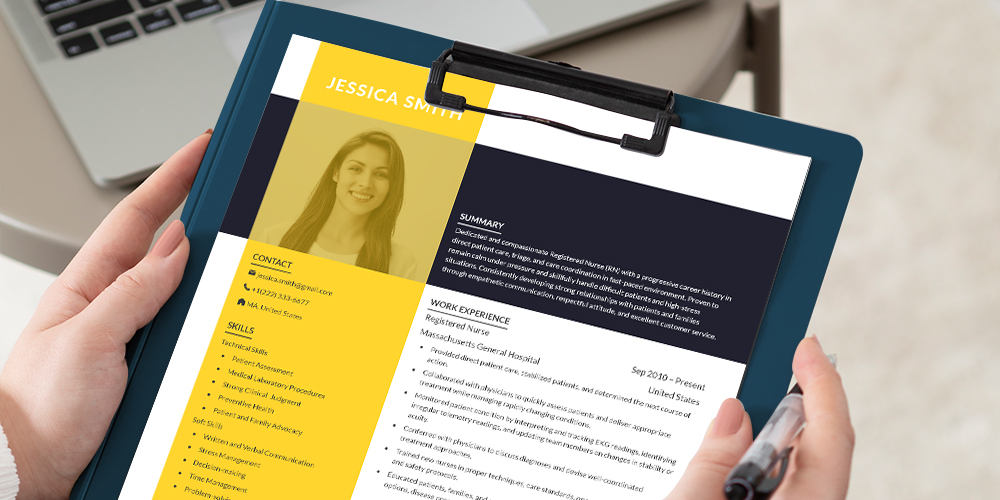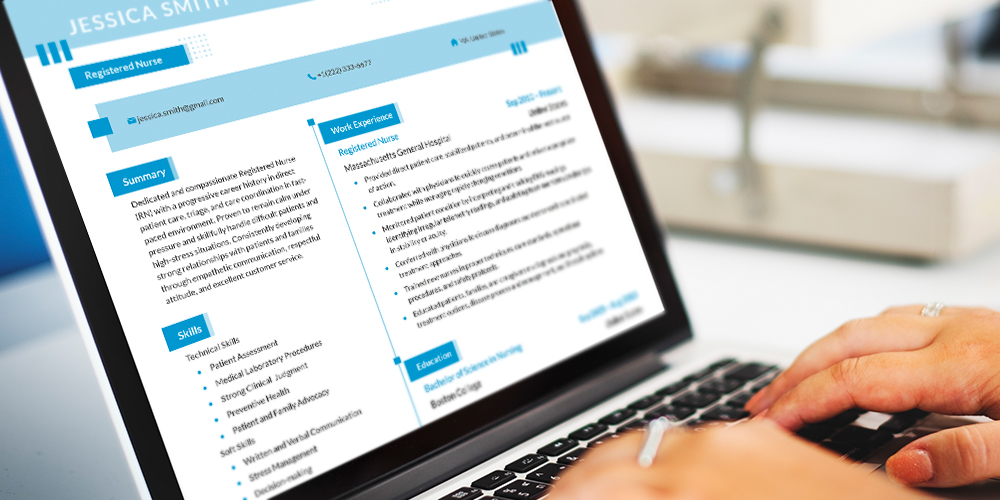
Your resume is a marketing document that summarizes your professional skills, work experience, education, and other relevant information. This resource is intended to be used as a guideline to help you build your resume for applying to universities/companies. Radviser, your intelligent adviser, got you covered and if you want to know how to write a perfect resume, read along.
1. Getting Started
The first step of “how to write a perfect resume” is to determine your objectives and have a clear mind.
- Think before you write. Take time to identify your key technical competencies and transferable skills, and consider how those skills suit the position you are applying to.
- Research the company (or research group) and position you are applying to. Your objective is to understand the business they are in (or field of study for students) and how the position you are applying to fits within their team and organization. Focus on key services, projects, clients, major competitors, corporate values, and strategic direction. On top of the company’s website, use tools like LinkedIn, check with your network of contacts, and search for any recent mentions in the media.
- Keep your content clear, concise, and relevant to the role. You have less than 30 seconds to convince a potential employer to consider you – tailor your resume for each application to highlight your most relevant skills and experience.
- Be honest and accurate. Never put information on your resume that you cannot back up in an interview. A good interviewer would easily identify false or embellished information.
2. How to Write Skill Statements in Resumes?
In order to fully understand how to write a perfect resume, you need to know how to manage your skills properly. Effectively describing tasks, projects, and/or responsibilities performed in previous roles is typically the hardest part of writing a resume. Your resume must create a clear picture of what you have previously achieved while conveying the relevant skills and knowledge that you offer to future employers.
Your goal is to write high-impact statements that:
- Enable the reader to understand the work performed easily.
- Incorporate quantifiable details (#, %, $) to provide scope and context.
- Emphasize the aspects most relevant to the position/employer by aligning with the competencies and terminology used in the job posting.
1. Identifying What to Write
Before you start writing, reflect on the work performed in your previous roles, and ask yourself:
- What department or team was I part of? What was the size of my team? What did I do on the team?
- What was the big picture objective or goal? What was my purpose in the role? How did I contribute to reaching the goals?
- What skills and knowledge did I use to complete the work? Consider both technical and non-technical skills.
- What equipment, tools, software, etc., did I use?
- Who did I communicate or interact with (roles/positions, not specific names)? How did I communicate with them?
- What were some of my biggest achievements in the role? How did I make things better? How did I meet or exceed my supervisor’s expectations? What am I most proud of?
- What did I receive positive feedback about? The feedback could have been written or verbal – from managers, colleagues, clients, etc.
- What attributes or characteristics did I use to perform the job?
- If unrelated to the position I am applying to, what are the transferable skills?
2. Writing Effective Statements
Depending on your experiences, you may choose to write Skill Statements or Achievement Statements. Skill Statements (SS) identify key competencies and work completed using the following formula:
- Skill Statement = Action Verb + Details + Outcome
Achievement Statements (AS) identify key actions and impacts using the following formula:
- Achievement Statement = Action Verb + Accomplishments + Results + Quantity
Example Statements | |
Before | After |
| Helped out by organizing parts | SS: Organized and maintained ~$5M of pumps and valves inventory using a customized database AS: Improved monthly inventory-count efficiently by 8% through accurately tracking and organizing ~$5M in oil tool inventory |
| Took orders, made specialty coffee drinks, served customers, and helped train co-workers | SS: Communicated effectively with 200+ customers per day to ensure accurate and efficient service AS: Trained and mentored three new hires to ensure 100% compliance with corporate standards and food handling safety procedures |
| Used hydrological and hydraulic process skills to identify safe and cost-effective design parameters for bridge rehabilitation and replacement structure projects | SS: Identified cost-effective, safe design parameters for bridge rehabilitation and replacement structures using hydrological and hydraulic process skills resulting in saving of $10K-$200K per project AS: Saved client $200K by using hydrological and hydraulic process skills to identify safe, cost-effective design parameters for a bridge replacement project |
3. Capturing Unrelated Experience and Emphasizing Transferable Skills
When applying to a position you have never held before, your resume should emphasize the transferable skills rather than listing the specific responsibilities or tasks performed. Transferable skills include technical skills (e.g., calculations, data analysis, interpreting engineering drawings, and so on) and soft skills (e.g., ability to deal with conflict, effective communications, initiative, and so forth). In other words, transferable Skills are those skills developed in one position that can be used to carry out various tasks or responsibilities in other roles like:
- Communication
- Conflict Resolution
- Creativity
- Decision Making
- Leadership
- Listening
- Organization
- Planning
- Problem Solving
- Safety
- Teamwork
- Time Management
The skills/achievement statements on your resume should help a potential employer understand the knowledge, qualities, and attributes you possess that will enable you to succeed in their positions.

4. Use Strong Action Verbs
The weak verbs like helped, supported, aided, and so on diminish the value of your skills. Use strong action verbs that convey relevant technical skills. Here is a glossary of select action verbs:
Communication and Training
Advised | Communicated | Defined | Facilitated | Meditated | Recommended | Solicited |
Arranged | Consulted | Developed | Initiated | Mentored | Reported | Specified |
Attended | Contacted | Discussed | Instructed | Networked | Represented | Trained |
Authored | Contributed | Edited | Interviewed | Presented | Resolved | Translated |
Collaborated | Demonstrated | Evaluated | Liaised | Read | Simplified | Wrote |
Project Management
Administered | Budgeted | Forecasted | Integrated | Organized | Projected | Screened |
Allocated | Changed | Handled | Led | Planned | Purchased | Strengthened |
Approved | Coordinated | Implemented | Managed | Prepared | Recruited | Supervised |
Assessed | Ensured | Improved | Marketed | Prioritized | Reduced | Tracked |
Assigned | Estimated | Increased | Negotiated | Procured | Scheduled | Updated |
Research and Technical
Adhered | Coded | Diagnosed | Formulated | Maintained | Produced | Standardized |
Adapted | Collected | Discovered | Gathered | Measured | Programmed | Streamlined |
Adjusted | Compared | Documented | Graphed | Modelled | Prototyped | Summarized |
Advanced | Compiled | Drafted | Identified | Modified | Proved | Surveyed |
Analyzed | Computed | Engineered | Innovated | Monitored | Remodeled | Synthesized |
Applied | Conducted | Examined | Inspected | Observed | Repaired | Systematized |
Assembled | Created | Experimented | Interpreted | Operated | Researched | Tested |
Built | Debugged | Extracted | Invented | Optimized | Reviewed | Trouble-shot |
Calculated | Designed | Fabricated | Investigated | Overhauled | Simulated | Upgraded |
Checked | Detected | Fixed | Located | Processed | Solved | Verified |
3. What Are the Sections of a Resume?
Now that you know the main steps of “how to write a perfect resume”, it is time to fill in all the sections of your resume. Below, we provide an overview of each resume section and what belongs in each.
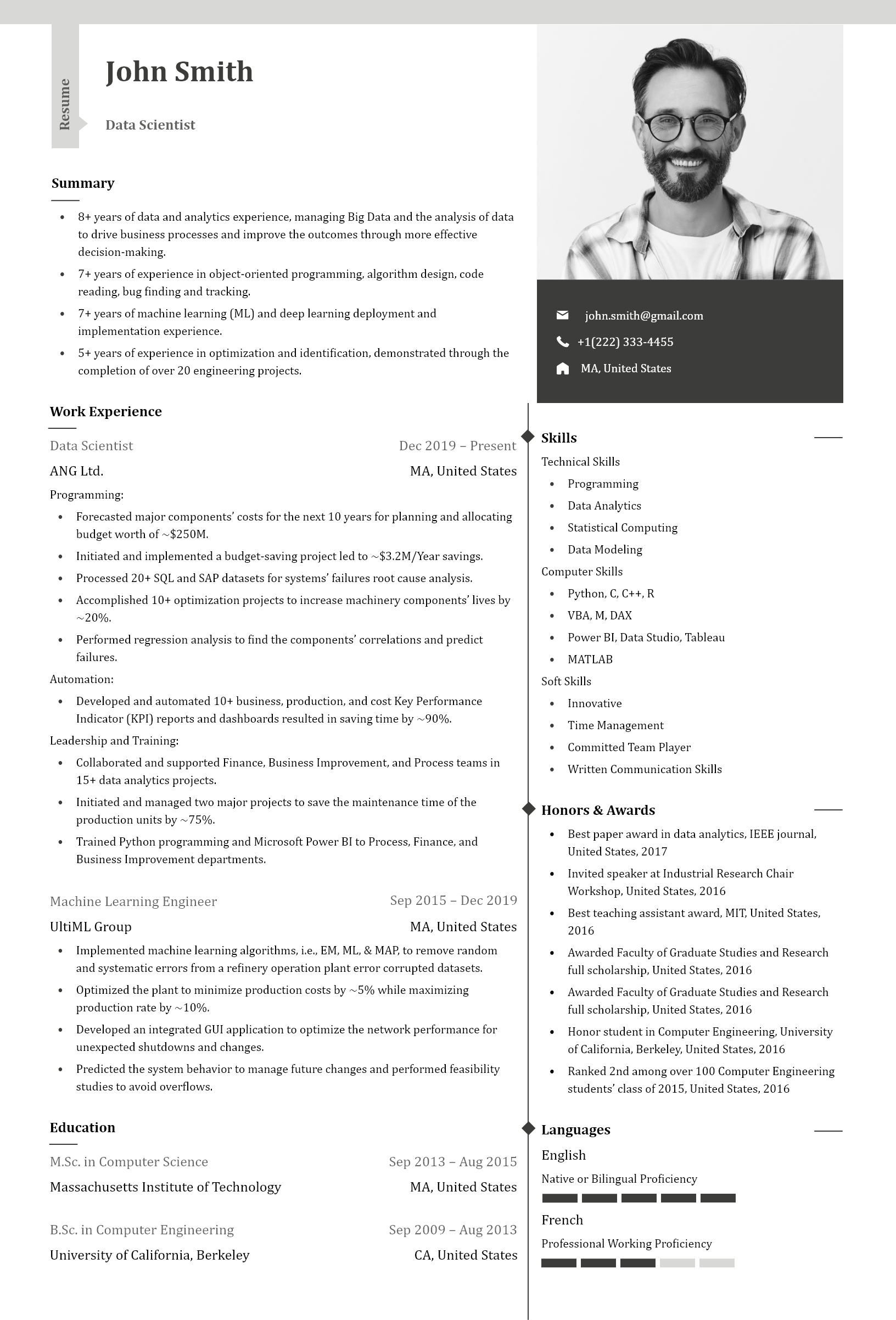
1. Header
The header contains your name and contact information:
- List your given (first) and last name. Your name should stand out – use the bold font or larger size. If you prefer to be called by a nickname, mention that not on your resume in your interview.
- List your phone number and a professional email address. Adding your mailing address is optional unless you are looking to relocate.
- You may wish to include URLs for your LinkedIn profile or development portfolios like GitHub, etc. Do not hyperlink URLs or your email address.
2. Objective (Optional)
In one or two sentences, state the type of position you are seeking and highlight your technical and transferable skills related to the position, company/industry. Summary:
- Must be specific to position, industry, and/or company, and communicate the availability
- Highlights your technical qualifications, transferable skills, industry experience
- Has to be short – one or two sentences
- Should not be started with “I” or “my”
Including the Objective section is optional but is recommended if your application package does not include a cover letter.
cover_1_dark_banner
3. Summary of Qualifications
- The Highlight of Qualifications section should be written with a specific position in mind.
- Highlight key technical skills, knowledge, and abilities relevant to the job you are applying to. Write your statement to reflect the types of competencies mentioned in the job posting.
- Summarize how much and what type of work experience you have in your first point.
- From reading this section, it should be evident what your discipline is and what type of position you are applying for (i.e., design, field, research, project, …)
- Avoid using jargon or acronyms. If you use any, make sure that every professional understands them, like HM (hiring managers) or HR (human resources).
- If mentioning software in this section, state what you used it for and what you accomplished with it.
- Never refer to yourself in the First Person. For instance, do not say “I am seeking …” or “I was responsible for ….”
- Use persuasive language to convince a potential employer that your qualifications will further the company’s objectives.’
Alternate Titles for “Summary of Qualifications”
- Profile
- Professional Profile
- Summary of Skills
- Key Skills
- Highlights of Qualifications
- Key Achievements
- Summary of Achievements
Write it last and align content to the job posting.
Do’s | Don’ts |
| Customize (align to employer’s needs) | Overstate qualifications or abilities |
| Use bullet-points | Use generic statements |
| Summarize experience | Bold keywords |
| Emphasize technical skills, knowledge, and abilities (not just “soft” skills) | Use paragraph format |
| List computer software | |
| Order by importance | Have more than 6 bullet- points |
Examples:
- 8 months combined mechanical engineering experience in the field and office roles for natural gas companies.
- Electrical engineering new grad with two years of research experience in improving power system stability.
4. Work Experience
The Work Experience section should include:
- Position title
- Dates of employment
- Company name
- Location
- Main accomplishments
- Key duties and responsibilities
Make this section compelling by not only listing your responsibilities but by showing the impact your work had. The first bullet point (sentence) should provide the context and purpose of your role. If related to the position, make sure to emphasize your key accomplishments rather than simply listing duties and responsibilities. It is recommended to use Achievement Statement Formula (Action Verb, Accomplishments, Results, Quantity) to define your accomplishments.
If your previous position is unrelated to the role you are applying to, be sure to emphasize transferable skills to highlight your suitability better. Turn each bullet point into a selling point using Skills Statement Formula (Action Verb, Details, Outcome) to describe key duties; each point (sentence) starts with an action verb, followed by the details and the outcome or purpose. For the outcome, try to include quantifiable data, i.e., #, %, $, where possible.
If you have both related and unrelated experience, you may want to create separate sections to showcase your relevant experience: Related Experience and Other Experience. Content for “Other Experience” should only cover:
- Position title
- Dates
- Company name
- Location
The Work Experience section can also be titled “Work History,” “Employment History,” or “Professional Experience.”
5. Education
The Education section should include:
- Degree(s)/diploma(s)
- Years of attendance
- School/University name and location
- Focus or specialization
If you have a college/university degree, include it in the education section. List your highest degrees first, the date you earned them, and the institution names. Mention high school if that is the highest level of education you have achieved. If you graduate with “Honors,” note it here. If a GPA is asked for in the requirement, list it here; otherwise, it is optional. If you have a limited employment history, you can describe it here under the education section.
Following is a list of optional content under education:
- Key electives
- Project work
- Academic achievements
- GPA
If you have numerous awards and achievements, you may group them under a common section on page 2.

6. Skills
Technical skills are recommended to showcase training and competency with software, industrial machines, lab equipment, … Define your skill level and similar group types of skills together, e.g., engineering-related skills.
- Add your most relevant hard skills by referring to the job description and emphasizing the skills listed there.
- Insert your valuable soft skills, like communication or customer service experience. These skills are sought after even in jobs where they may not seem applicable.
- Round out this section with any applicable transferable skills you possess.
7. Memberships and Certifications
Any professional or relevant Memberships and Certificates should be included in this section. If a job description asks you to be already a member or eligible to become a member of a particular Society or Association, and you are, then you should include them here.
8. Publications and Conferences
In this section, you may include a summary statement and attach it as an appendix or indicate available upon request, e.g., Authored three journal papers and presented at two industry conferences. Or you can present the titles, name of authors, journal/conference name, as well as dates.
9. Awards and Achievements
In this section, you should list the name of your awards and achievements and the dates you received them.
10. Community Involvement
Here you should list the role or position title, the organization name, and dates. Community Involvement may also be called “Volunteer Experience.” If you hold/held volunteer leadership roles, it is recommended that you use “Leadership Activities” as the heading and format the content similar to the Work Experience section.
11. Other Information
Use this section to provide details that do not fit in elsewhere. You may also choose to create other sections like:
- Professional Development
- Research Projects
- Design Projects
- Team Activities
- Extracurricular Activities
- Patents
- Athletics
- Competitions
12. References
Do not include References on your resume. You may indicate that references are “Available upon request”; however, this is optional. References should be on a separate page, formatted with the same header as the first page of your resume. Include reference’s name, title, organization/company, and contact information. Do not send References with your application unless it is specifically requested.
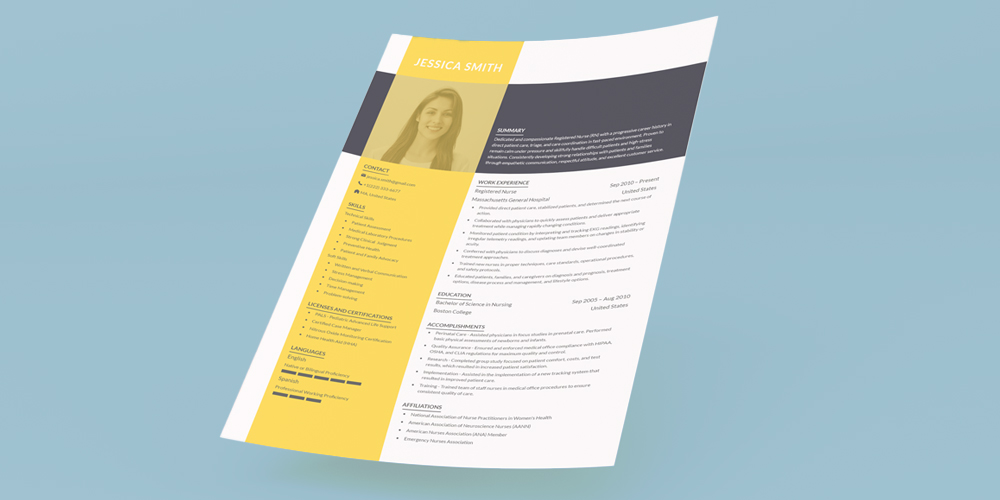
4. Check Your Formatting
Resume formatting can be a pain in the neck, but it does not have to be one. Let’s talk about basic resume formatting – like how long your resume should be, fonts you should use, and margin widths. Below is a resume formatting basic list to keep in mind as you write your document:
1. Length
The basic rule of thumb is to write one page per decade of work experience, with a maximum of two decades worth of experience represented on your resume. Whenever possible, keep your resume to just one page. Given that hiring managers spend just 6 seconds scanning each resume they review, they will never get to the second page of your resume.
2. Margins
When setting the margins on your resume, stick to 0.61 inches on the sides and 0.9 inches at the top whenever possible. If you need to adjust your margins, remember not to go smaller than 0.5 inches on any side (will make your resume feel too crowded) or larger than 1.25 inches (will make it look like you’re trying to hide something).
3. Fonts
Choose an easy-to-read font such as Avenir, Calibri, or Times New Roman. Once you have chosen a font, remember to stick to 10- to 12-point font size. We have organized this on a scale from more modern to more traditional.

4. Alignment
Each section of your resume will be formatted and aligned slightly differently. Below, we have outlined some basic formatting rules:
- Main Resume Sections: Your Professional Summary, Work History, Skills, etc., should be left-aligned for readability.
- Header: Depending on the header you choose, the contact information in your header should be center-aligned, which is more traditional or left-aligned, a feature of some modern resumes.
- Employment Dates: The dates of employment for your past roles should either be right-aligned across from the company name or job title or left-aligned under the company name.
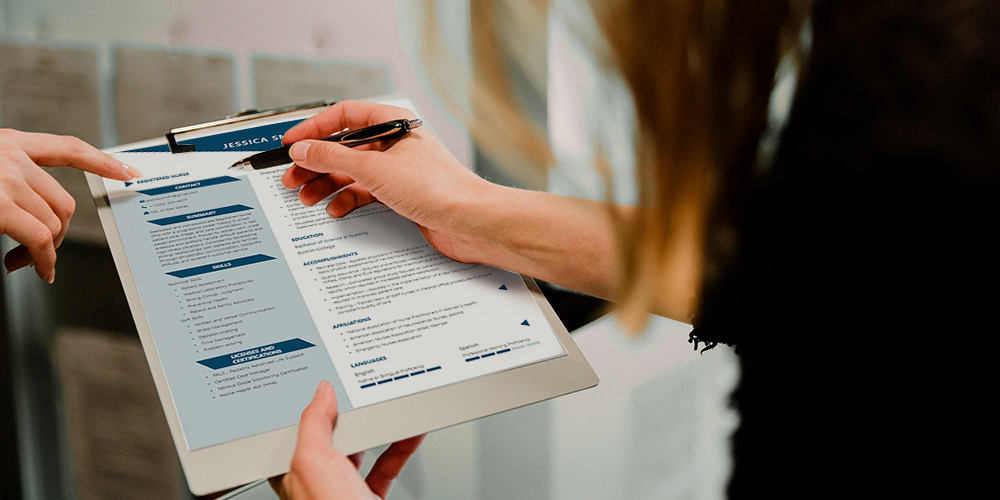
5. Proofread Your Document
Nothing will land a great resume in the trash faster than typos and grammatical errors. Before you send out a resume, take the time to proofread your document. Make sure that your resume is well-formatted and error-free. Here is how:
- Do not JUST rely on spell-check or grammar-check.
- Read your resume top to bottom at least twice.
- Read your resume out loud.
- Ask someone you trust to review the content and proofread it. When you have read a document over several times, it is sometimes hard to see your errors.
- Use an online grammar and spell-check tool. These are typically free and will make suggestions for how to polish your writing.
resume_1_dark_banner
Final Words
In this post, we discussed some Do’s and Don’ts of how to write a perfect resume that stands out. Note that you may choose to change the order of sections and/or use different headings to best highlight your experience and expertise, but knowing how to write a perfect resume that stands out will give you the power to present yourself effectively. A good resume must concisely and strategically show your qualifications to get a recruiter interested in meeting you or offering you an interview. You want a resume that conveys your skills, work experience, and assets. A perfect resume is used to describe what you can accomplish professionally in a manner that represents what you can do for an employer. Learning how to write a perfect resume can help increase job opportunities unexpectedly. The key to a successful job search is an updated resume. If you are wondering about the job haunting process and interview tips, check out Radviser’s Library to educate yourself in the best way possible.





